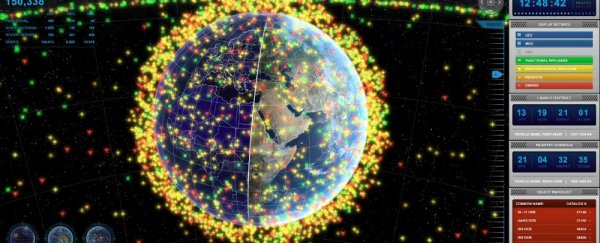The US Air Force's capability to monitor space debris is getting a $914-million upgrade, with construction of a new ground-based tracking system beginning this month.
There are an estimated 500,000 pieces of space debris polluting our planet's orbit, and they are generally circling Earth at speeds of around 8 kilometres per second (that's nearing 30,000 kilometres per hour).
So, this debris is moving pretty damn fast… literally 10 times the speed of a bullet fired from an AK-47.
Consequently, even the smallest pieces of debris (the ones we can't yet track consistently) can have catastrophic impacts if they collide with satellites, or manned spacecraft, like the International Space Station (ISS). (We've all seen Gravity, right?)
In fact, the ISS has to change its course about once per year to avoid debris passing within a few kilometres.
Tracking space debris is important for the security of space-based assets, especially as more satellites are launched into orbit, but it's a difficult task.
The US Space Surveillance Network only tracks pieces of debris larger than 10 cm, and therefore, only has a handle on about 23,000 hazards - less than five percent of all debris.
To bolster their capability, the US Air Force has contracted Lockheed Martin to develop the Space Fence, which will be able to detect objects as small as marbles.
If you ignore the very dramatic music, and the doom and gloom narration at the outset, this promotional Lockheed Martin video goes someway to explaining how the system will work.
And this infographic helps break it down further, explaining why the Space Fence is so important (particuarly for America's national security interests).
The ground-based system of s-band radars will be located on the Marshall Islands, near the equator in the Pacific Ocean, with an option for another radar site in Western Australia.
It has been "designed to greatly enhance the Air Force Space Surveillance Network. It provides unprecedented sensitivity, coverage and tracking accuracy," the video states.
"Space Fence not only tracks objects, but can precisely determine their projected orbit. This allows operators to reconstruct recent events, such as collisions, or satellite breakups, and accurately predict future events."
In addition, the system can "electronically construct" a "micro fence" (which is akin to a shield) around high-value, or high-interest spacecraft.
In theory, more comprehensive tracking means greater security, and some piece of mind for spacecraft operators and astronauts. But it also means more data to sift through, and potentially harder choices to make.
"The flood of information passed along to non-military spacecraft operators will bring reassurance—but also some wrenching choices about which hazards to ignore," wrote Ilima Loomis in the 9 January edition of Science.
Loomis says the ISS receives about 12 to 15 warnings per month about debris, but only a few are serious enough to result in direct action, such as changing course. It is expected that the new system could generate up to 10 times as many warnings.
Sources: Smithsonian.com, Science
